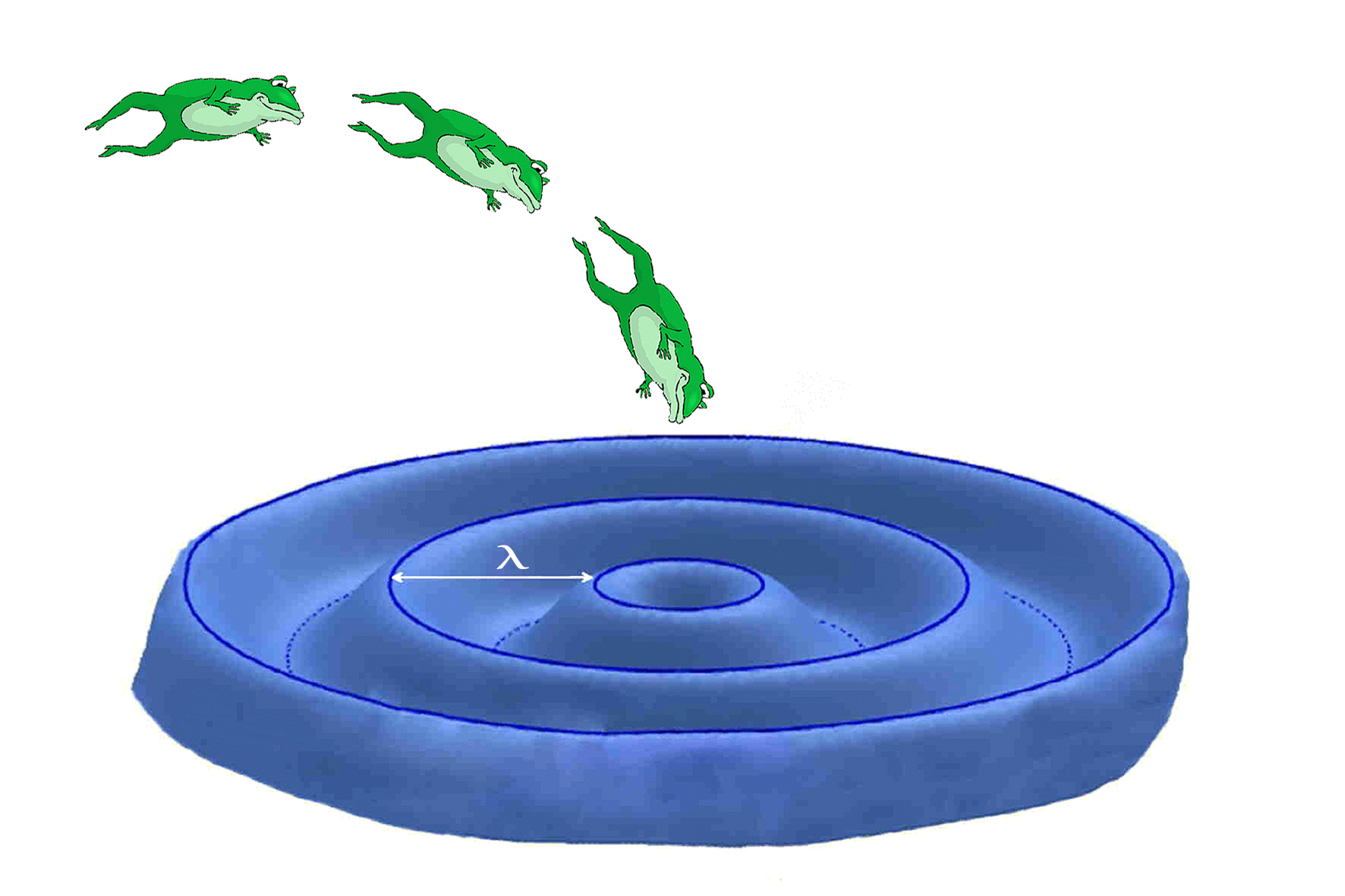 Deutsch Deutsch |
Funny Physics | Explaining physics with funny A new series that simplifies access to physical content with the help of funny representations. The presentation is aimed at interested readers who are familiar with mechanics in the field of waves, as well as basic knowledge in atomic physics. The Frog Laser
LASER is an English artificial word and stands for: 1.0: Funny representation Imagine a round pond (P) where frogs live. The pond is located in a depression. In addition to the pond (P), the depression has at least 2 terraces Thigh, (yellow) and Tlow, (light green), wherein the lower one (Tlow) is demarcated with a small fence. On the side, a frog excavator (Fe) ensures that the frogs can get from the pond (P) to the upper terrace (Thigh). 1.1: Physical content Laser radiation is generated only in a material that has very specific properties at the atomic level. Laser radiation is an electronic energy transfer from a metastable excited State (Tlow) into the ground state (P). The metastable state is characterized by the fact that the residence or lifetime of the electrons are particularly long there and thus an overoccupation of electrons can be generated. Overoccupation means that the state contains more electrons than the rules of atomic physics pretend. Optical pumping rises electrons of the ground state (P) into an energy level (Thigh) that is above the metastable state. From there, they usually fall into the (Tlow) state without radiation and create overcrowding there. In the analogy, one identifies the frogs with electrons, the pond (P) with the ground state E0, the upper terrace (Thigh) with E2 and the terrace with fence (Tlow)) with E1. The fence creates the increased Lifetime of the electrons in this state and makes overcrowding possible. The optical pump is realized and powered by the Frog excavator (Fe). Back to top 2.0: Funny representation Since frogs are sociable animals, they hop independently from the upper plateau (Thigh, yellow) to the Platform with the fence (Tlow). At some point it gets tight there. The frogs crowd against the fence. 2.1: Physical content The excited state (Thigh = E2) empties and gradually fills the metastable state (Tlow = E1) until the desired overcrowding occurs. Back to top 3.0: Funny representation Again and again there is a frog that gets nervous by the unbearable narrowness.
And then it happens: 3.1: In physical words: This process is called "induced emission". The laser material emits electromagnetic radiation in form of e.g. red light. Red light has the unimaginably high frequency of 462 THz (1 tera-Hz is 1012 Hz). Somewhat more handy is the indication of its wavelength λ. It is measured in nanometers (1 nm = 10-9 m), where red light has a wavelength of about 650 nm. The induced emission can also be referred to as deadweight. An electron jumps spontaneously, thereby stimulating a large number of other electrons to jump into the ground state. E0. ΔE = h ° f
Back to top 4.0: Funny content By the time, it also becomes tight in the ground state (P = E0), which decreases the jumping of the frogs from the fenced platform. However, since the provision of frogs by the frog excavator Fe is still in operation, frogs can continuously jump from the fenced platform Tlow into the pond P. If this is also done with a constant clock, the "frog laser" is almost perfect. 5.1: The physicists say: The light amplification is achieved by another so called optical resonator. If you design the laser-active material as a circular disk, you can create waves analogous to the frog pond and strengthen them. In contrast to the frog pond, the wave now consists of electromagnetic radiation. The wave-speed of propagation corresponds to the speed of light in the medium. λ = CLm ° f With λ the wavelength, CLm the propagation speed in the laser disk and f the lights frequency, i.e. the colour of the light. Now only the resonance condition has to be met. You can reach this by selecting the dimensions of the laser disc to: R = n ° λ Where R is the radius of the circular disk, n is an integer natural number, and λ the wavelength.Back to top 6.0: Other embodiments: Laser radiation can also be generated in different designed materials and shapes. In section 5.1, a circular disk was used for the laser-active material. But it is also possible to to excite radiation in a cylindrical rod, whereby the frog pond analogy can no longer be used. Hopefully the frogs are not too angry with me! 6.1: A longitudinal laser: So if instead of the circular disc you use a cylindrical hollow rod, similar to a flute, you can excite a longitudinal or longitudinal wave in it. Instead of water, air is now the vibrating material and the waves are called sound waves. It is well known that the flute length or the choice of hole distance will determine frequency. 6.2: How does the physicist explain this phenomenon? Sound waves are longitudinal pressure waves, in which the air molecules oscillate in contrast to the transverse waves, in the direction of propagation of the waves. Maxima = high pressure alternate regularly with minima = low pressure. The Distance between 2 consecutive wave crests or wave troughs is called wavelength. The wave height is called Amplitude. Between each crest and trough there is a zero crossing. In this place are the air particles at rest. If you use a flute, there is no turbulence at this point and you can drill a hole there, without disturbing the air currents. If the hole spacing of the flute is an integer multiple of the generated wavelength, then the above mentioned resonance condition is met. In the flute waves can exist as standing waves and you are able to amplify them. Similar to the sound waves in the air, longitudinal waves also propagate in solids, e.g. a ruby crystal rod. If one transfers the analogy back to the laser, then the hole spacing of the Flute is the length of the ruby stick which must be ground exactly. In addition you can fully mirror the left side and partly mirror the right side of the rod. Now you are able to determine the resonance condition. The light amplification can be adjusted via the partial mirroring. You may only extract as much as radiation energy from the system, that induced emission does not come to standstill. Otherwise the oszillation breaks off. Back to top 7.0: Summary: Back to top Copyright by Hans Joachim Ilgen since 1950 |
|
 Fig. 1: Frogs pond with frogs excavator
Fig. 1: Frogs pond with frogs excavator
 Fig. 2: The laser transition
Fig. 2: The laser transition
 Fig. 3: Migration of frogs
Fig. 3: Migration of frogs
 Fig. 4: The "induced emission"
Fig. 4: The "induced emission"
 Fig. 6: A standing circular wave
Fig. 6: A standing circular wave

 Fig. 8: Sinusoidal oscillation of a pressure wave
Fig. 8: Sinusoidal oscillation of a pressure wave